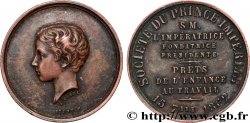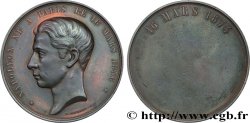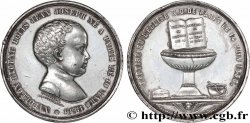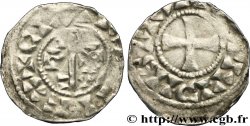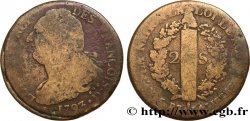E-auction 225-149674 - fjt_417900 - NAPOLÉON IV Naissance - quinaire 1856
得先注册又得到批准才可以报价。为了报价注册. 客户应该得到公司允许,那种过程需要 48 个小时。别等出售结束那一天才登记。您报价的话等于您赞成买那物品,而且按« 保价 » 证明您接受 cgb.fr 因特网拍卖使用法.
报价时只可以出全数值欧元总额。物品描述也说明销售结束时间,结束后出价都不会生效。 报价命令转达有时变动,等到最后秒钟增加否决的可能会。想多了解的话请注意 因特网拍卖常问
购货人不付费
购货人不付费
| 估算 : | 15 € |
| 价格 : | 4 € |
| 最高出价 : | 11 € |
| 拍卖结束日期 : | 07 August 2017 18:41:30 |
| 竞拍人 : | 3 竞拍人 |
种类 Naissance - quinaire
日期: 1856
材质 silver
直径 15 mm
模子方针 12 h.
重量 1,93 g.
侧面 lisse
印模 Main
正面
正面的说明书 Bustes en jugate de l'empereur Napoléon III et de son épouse l'impératrice Eugénie.
背面
背面的文字 14 JUIN 1856.
背面的说明书 Buste de leur fils, futur Napoléon IV.
评论
Le poinçon de ce jeton est une main indicatrice mais sans le mot ARGENT, ce qui s’explique probablement par la taille du jeton.
Ce jeton a certainement été frappé pour commémorer le baptême de leur fils Napoléon IV et distribué à la foule lors des réjouissances.
Wikipedia nous informe de la cérémonie :
L'arrivée au monde de cet héritier fut pénible pour l'impératrice Eugénie qui a beaucoup souffert en lui donnant la vie. Il fallut recourir aux fers dont l'enfant porta au front les traces. Pour la naissance du prince, la ville de Paris lui offrit un berceau aux armes de l'Empire (ce berceau est toujours visible au musée Carnavalet à Paris).
Le 14 juin 1856, le prince impérial fut baptisé en grande pompe à Notre-Dame de Paris. Napoléon III dit de la cérémonie et des réjouissances qui s'en suivirent : « Un tel baptème vaut bien un sacre.» La famille impériale fut conduite dans le carrosse qui servit à Reims, lors du sacre de Charles X. Le parrain est le pape Pie IX et la marraine est la reine Victoria d'Angleterre. Cependant, celle-ci étant de religion anglicane, c'est la reine de Suède, Joséphine, fille d'Eugène de Beauharnais, cousine de l'empereur, qui la représente. Le pape se fit représenter par le cardinal-légat Patrizzi, qui baptisa l'enfant.
Dans l'acte officiel, conservé sur le registre des baptêmes de l'église Saint-Germain-l'Auxerrois, dont dépendait la chapelle des Tuileries, il fut déclaré "fils de France", titre que Napoléon Ier avait utilisé pour son fils, le roi de Rome, et repris de l'Ancien régime. Il fut question de lui donner un titre royal, celui de Roi d'Alger, mais cette idée fut abandonnée.
La suite à http://fr.wikipedia.org/wiki/Louis_Napol%C3%A9on_Bonaparte_%28Prince_imp%C3%A9rial%29.
The hallmark of this token is an indicator hand but without the word SILVER, which is probably explained by the size of the token.
This token was certainly struck to commemorate the baptism of their son Napoleon IV and distributed to the crowd during the celebrations..
Wikipedia tells us about the ceremony: The arrival of this heir was painful for Empress Eugenie, who suffered greatly in giving birth to him.. It was necessary to resort to irons, the marks of which were left on the child's forehead.. For the birth of the prince, the city of Paris offered him a cradle bearing the coat of arms of the Empire (this cradle can still be seen at the Carnavalet Museum in Paris).
On June 14, 1856, the Prince Imperial was baptized with great pomp at Notre-Dame de Paris.. Napoleon III said of the ceremony and the festivities that followed: \\\"Such a baptism is well worth a coronation.\\\". \\\"The imperial family was driven in the carriage that was used in Reims during the coronation of Charles X. The godfather is Pope Pius IX and the godmother is Queen Victoria of England. However, since she was of the Anglican religion, it was the Queen of Sweden, Josephine, daughter of Eugène de Beauharnais, cousin of the Emperor, who represented her.. The Pope was represented by Cardinal Legate Patrizzi, who baptized the child.
In the official document, preserved in the baptismal register of the church of Saint-Germain-l'Auxerrois, on which the chapel of the Tuileries depended, he was declared \\\"son of France\\\", a title that Napoleon I had used for his son, the King of Rome, and taken from the Ancien Régime. There was talk of giving him a royal title, that of King of Algiers, but this idea was abandoned..
Continued at http://fr. Wikipedia. org/wiki/Louis_Napol%C3%A9on_Bonaparte_%28Prince_imp%C3%A9rial%29
Ce jeton a certainement été frappé pour commémorer le baptême de leur fils Napoléon IV et distribué à la foule lors des réjouissances.
Wikipedia nous informe de la cérémonie :
L'arrivée au monde de cet héritier fut pénible pour l'impératrice Eugénie qui a beaucoup souffert en lui donnant la vie. Il fallut recourir aux fers dont l'enfant porta au front les traces. Pour la naissance du prince, la ville de Paris lui offrit un berceau aux armes de l'Empire (ce berceau est toujours visible au musée Carnavalet à Paris).
Le 14 juin 1856, le prince impérial fut baptisé en grande pompe à Notre-Dame de Paris. Napoléon III dit de la cérémonie et des réjouissances qui s'en suivirent : « Un tel baptème vaut bien un sacre.» La famille impériale fut conduite dans le carrosse qui servit à Reims, lors du sacre de Charles X. Le parrain est le pape Pie IX et la marraine est la reine Victoria d'Angleterre. Cependant, celle-ci étant de religion anglicane, c'est la reine de Suède, Joséphine, fille d'Eugène de Beauharnais, cousine de l'empereur, qui la représente. Le pape se fit représenter par le cardinal-légat Patrizzi, qui baptisa l'enfant.
Dans l'acte officiel, conservé sur le registre des baptêmes de l'église Saint-Germain-l'Auxerrois, dont dépendait la chapelle des Tuileries, il fut déclaré "fils de France", titre que Napoléon Ier avait utilisé pour son fils, le roi de Rome, et repris de l'Ancien régime. Il fut question de lui donner un titre royal, celui de Roi d'Alger, mais cette idée fut abandonnée.
La suite à http://fr.wikipedia.org/wiki/Louis_Napol%C3%A9on_Bonaparte_%28Prince_imp%C3%A9rial%29.
The hallmark of this token is an indicator hand but without the word SILVER, which is probably explained by the size of the token.
This token was certainly struck to commemorate the baptism of their son Napoleon IV and distributed to the crowd during the celebrations..
Wikipedia tells us about the ceremony: The arrival of this heir was painful for Empress Eugenie, who suffered greatly in giving birth to him.. It was necessary to resort to irons, the marks of which were left on the child's forehead.. For the birth of the prince, the city of Paris offered him a cradle bearing the coat of arms of the Empire (this cradle can still be seen at the Carnavalet Museum in Paris).
On June 14, 1856, the Prince Imperial was baptized with great pomp at Notre-Dame de Paris.. Napoleon III said of the ceremony and the festivities that followed: \\\"Such a baptism is well worth a coronation.\\\". \\\"The imperial family was driven in the carriage that was used in Reims during the coronation of Charles X. The godfather is Pope Pius IX and the godmother is Queen Victoria of England. However, since she was of the Anglican religion, it was the Queen of Sweden, Josephine, daughter of Eugène de Beauharnais, cousin of the Emperor, who represented her.. The Pope was represented by Cardinal Legate Patrizzi, who baptized the child.
In the official document, preserved in the baptismal register of the church of Saint-Germain-l'Auxerrois, on which the chapel of the Tuileries depended, he was declared \\\"son of France\\\", a title that Napoleon I had used for his son, the King of Rome, and taken from the Ancien Régime. There was talk of giving him a royal title, that of King of Algiers, but this idea was abandoned..
Continued at http://fr. Wikipedia. org/wiki/Louis_Napol%C3%A9on_Bonaparte_%28Prince_imp%C3%A9rial%29







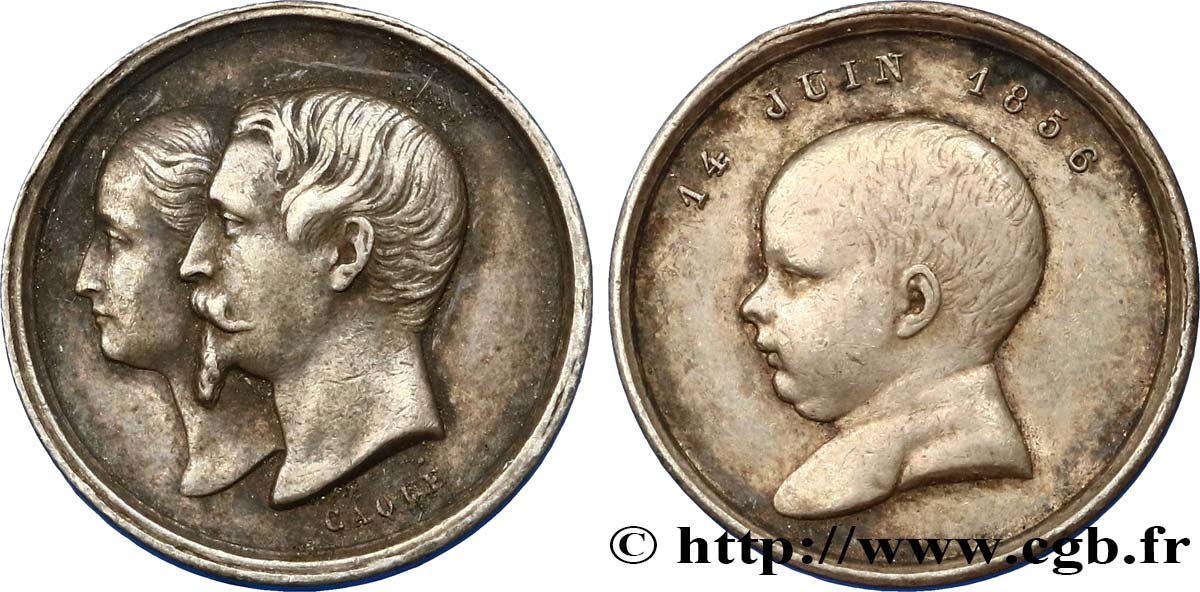
 对产品描述纠错
对产品描述纠错 打印
打印 分享我的选择
分享我的选择 提问
提问 Consign / sell
Consign / sell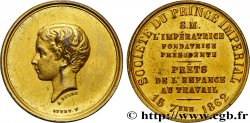
 产品介绍
产品介绍
